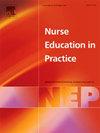Exploring professional development perceptions among health and social care educators: A cross-sectional study with cluster analysis
IF 3.3
3区 医学
Q1 NURSING
引用次数: 0
Abstract
Aim
This study aimed to evaluate Finnish educators’ perceptions of their current level of continuing professional development and to identify distinct profiles in their competence development.
Background
The current health and social care system faces multiple challenges, including aging populations, cultural diversity and increasingly complex client needs. To implement new digital and interprofessional working methods, professionals must be highly competent and innovative. Educators’ professional development is crucial for delivering high-quality education.
Desing
The study used secondary analysis of a cross-sectional survey.
Methods
The initial study developed the EduProDe scale and the study sample comprised 422 educators in health and social education. IBM SPSS Statistics version 25.0 was used for secondary statistical analysis. Descriptive statistics were calculated and the different groups among educators were based on the subdimensions of the EduProDe scale. The continuing professional development profiles were described using groups identified by K-means clustering.
Results
Based on educators´ responses to the EduProDe scale, they were clustered into three significantly different profiles: Experiencing Support for Continuous Learning (A), Needing Support for Continuous Learning (B) and Self-Directed Learners (C).
Conclusion
The results show that health and social care educators are diverse learners. It’s important to consider their individual characteristics, like education and work field, when planning professional development. In addition, the findings enhance the support for continuous learning from educators’ superiors. Through this knowledge, organizations can consider factors beyond learning needs when planning professional development.
探讨健康与社会关怀教育工作者的专业发展观念:一项具有聚类分析的横断面研究
目的本研究旨在评估芬兰教育工作者对其当前持续专业发展水平的看法,并确定其能力发展的不同概况。当前的卫生和社会保健系统面临着多重挑战,包括人口老龄化、文化多样性和日益复杂的客户需求。为了实施新的数字化和跨专业工作方法,专业人员必须具有高度的能力和创新能力。教育工作者的专业发展是提供高质量教育的关键。设计本研究采用横断面调查的二次分析。方法采用EduProDe量表对422名卫生社会教育工作者进行问卷调查。采用IBM SPSS Statistics 25.0版本进行二次统计分析。计算描述性统计数据,并根据EduProDe量表的子维度对教育者进行分组。持续的专业发展概况是用k均值聚类识别的组来描述的。结果根据教育工作者对EduProDe量表的反应,他们被聚类成体验持续学习支持(A)、需要持续学习支持(B)和自主学习者(C)三个显著不同的类型。结论结果表明,卫生和社会保健教育工作者是多元化的学习者。在规划职业发展时,考虑他们的个人特征很重要,比如教育和工作领域。此外,研究结果亦增强了教师上司对持续学习的支持。通过这些知识,组织在规划专业发展时可以考虑学习需求之外的因素。
本文章由计算机程序翻译,如有差异,请以英文原文为准。
求助全文
约1分钟内获得全文
求助全文
来源期刊

Nurse Education in Practice
NURSING-
CiteScore
5.40
自引率
9.40%
发文量
180
审稿时长
51 days
期刊介绍:
Nurse Education in Practice enables lecturers and practitioners to both share and disseminate evidence that demonstrates the actual practice of education as it is experienced in the realities of their respective work environments. It is supportive of new authors and will be at the forefront in publishing individual and collaborative papers that demonstrate the link between education and practice.
 求助内容:
求助内容: 应助结果提醒方式:
应助结果提醒方式:


